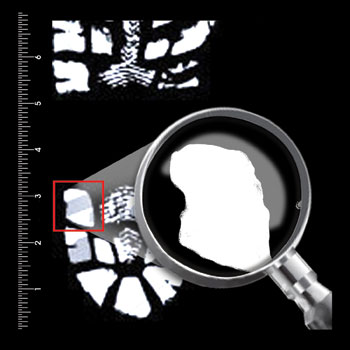German police are using high-resolution USB cameras to image shoe prints left at crime scenes.
Thomas Schmidgall, Imaging Development Systems GmbH
The perfect crime is all but impossible because every criminal leaves at least a trace of evidence at the scene.
These can be fingerprints, microparticles, DNA material or, more commonly, shoe prints. Such prints are difficult to avoid, especially for burglars. Therefore, they often provide substantive evidence and are an important tool for police in solving property crimes and other offenses.
In the course of its lifetime, every shoe sole develops a unique structure (Figure 1) that is caused by different factors, including age, wear, the owner’s motion characteristics and foreign materials such as gravel and grit. If such detailed structures of a sole show in a print, the print was made by precisely that shoe — and by no other shoe of the same tread and size. Thus, a shoe print has considerable probative force, provided, of course, that the wearer of the shoe can be determined beyond a doubt.

Figure 1. The state criminal police office in Baden-Württemberg, Germany, is using high-resolution cameras to acquire images of shoe prints left at crimes scenes, often relying on minute detail to separate one print from another. A database has been compiled and is used to cross-check evidence.
Detectives now are using a computer database to store shoe treads and outsole prints, allowing the database to be queried and stored prints to be matched quickly to fresh prints discovered at a crime scene. The procedure of entering all the tread patterns into this system is crucial. Image acquisition and processing must be precise, fast and efficient if the data is to be of use to police. For this purpose, the state criminal police office in the German state of Baden-Württemberg is using high-resolution uEye series cameras manufactured by IDS GmbH of Obersulm, Germany, to image the prints.
Reproduction stations located in police laboratories are outfitted with a fluorescent lamp, which is easy to use and can be adjusted as needed, and a single camera. Detectives take images of plaster casts or of the 2-D photos of shoe print fragments taken at the crime scene. These photos can be provided as black or transparent film or as black-on-white comparison prints of shoe treads.
The reproduction system uses a USB camera with a 1/2-in. CMOS sensor and 2048 × 1536-pixel resolution. This model achieves a rate of 11 frames per second, measures 34 × 32 × 27.4 mm, and weighs 62 g. The resolution, in particular, is critical for this application because tiny details in a shoe print can make the difference in a positive identification.
In contrast to flatbed scanners, which can analyze only 2-D objects, the reproduction system allows for highly individual lighting and an excellent depth of field, providing 3-D detail that detectives need. All of the reproduction station settings are optimized directly with the live image until the resulting image shows the appropriate level of detail for on-screen comparison. It then can be stored in the central shoe print database, enabling it to be matched with the contents of the statewide database, which comprises not only crime scene prints but also a comprehensive reference collection of many common tread and outsole patterns.
For the police department to continue using its existing ISASPro image software, it was essential that the camera’s control software be adapted individually and with little effort. This was accomplished by expanding the code that is delivered with the camera package.
However, it was unnecessary to customize the camera in this case because the models of the standard line were suited for the reproduction stations. And although police decline to reveal how extensive — or effective — the shoe print database has been to date, it now is in use at five data entry stations.
Meet the author
Thomas Schmidgall is head of marketing at Imaging Development Systems in Obersulm, Germany; e-mail: [email protected].